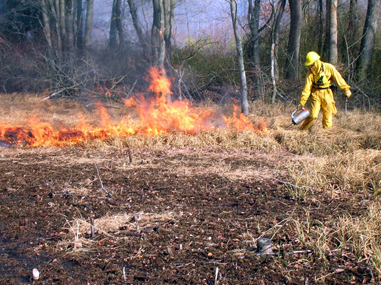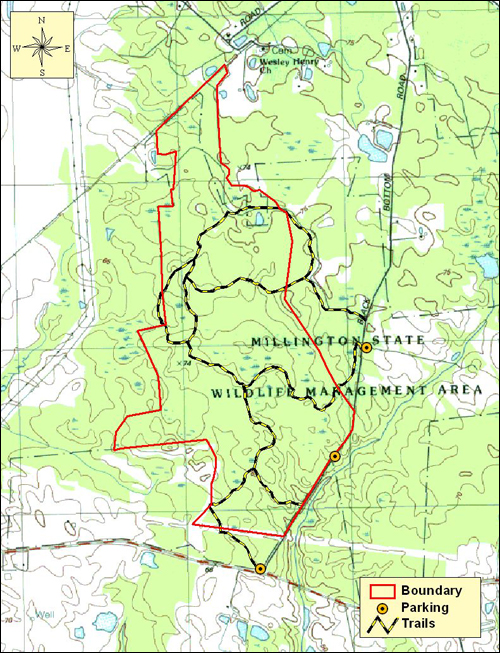Millington, Kent County
 Millington Natural Area is a large forested area consisting of seasonally flooded woods located northeast of the town of Millington near the Delaware-Maryland border. Part of Millington's woods contain forested hiking trails and ample opportunities to view an abundance of wildlife. Many small seasonal wetlands are distributed randomly throughout the forest. Known officially as Carolina Bays, these wetlands are also called Delmarva Bays, whale wallows and seasonal ponds. The combination of these distinctive habitats at Millington Natural Area supports seven rare, threatened and endangered plants and animals, six of which are found in the Carolina Bays. The rare species at Millington include five plants and two amphibians. Among the most interesting rare species found here is the Endangered featherfoil (Hottonia inflata), a very unusual aquatic plant with floating fans of feather-shaped leaves.
Millington Natural Area is a large forested area consisting of seasonally flooded woods located northeast of the town of Millington near the Delaware-Maryland border. Part of Millington's woods contain forested hiking trails and ample opportunities to view an abundance of wildlife. Many small seasonal wetlands are distributed randomly throughout the forest. Known officially as Carolina Bays, these wetlands are also called Delmarva Bays, whale wallows and seasonal ponds. The combination of these distinctive habitats at Millington Natural Area supports seven rare, threatened and endangered plants and animals, six of which are found in the Carolina Bays. The rare species at Millington include five plants and two amphibians. Among the most interesting rare species found here is the Endangered featherfoil (Hottonia inflata), a very unusual aquatic plant with floating fans of feather-shaped leaves.
Millington Natural Area is owned by the State of Maryland and managed as a component of the Millington Wildlife Management Area. This forested area is heavily utilized by hunters during hunting season. Millington's location on the northern Eastern Shore partially explains the abundance of Carolina Bays present. Easily visible from aerial photography, these wetlands are very common on the mid- to northern Eastern Shore where dense bands of bays formed across the landscape. Many of these wetlands have been ditched and degraded for human use. These "ghost" bays, as they are sometimes called, are easily seen in the aerial images, and visible in agricultural fields.

Carolina Bays
Carolina Bays are elliptical wetlands that hold water during the winter and spring months and typically dry out entirely during the dry summer and fall months. During the wet period they provide exceptional habitat for amphibian species like the New Jersey chorus frog, as well as other frogs and salamanders. When these areas dry they become significant habitats for many rare plant species that require this specialized flooding-drying cycle. These wetlands are believed to have been created by prevailing winds during the Pleistocene Epoch when the Shore was just being exposed by the receding ocean.
Natural Fires: Friend, not Foe
 Fire was once a major force in the coastal areas of Maryland as well as an essential component needed for Carolina Bays. Without fire disturbance, bays eventually become filled with woody shrubs and ultimately trees. Closed tree canopies later shade out sun-loving plant species found within these ecosystems, many of which are rare. In the future, prescribed burns may be used by Department of Natural Resources ecologists to keep the Carolina Bays free of shrubs and trees and allow the rare plants to survive.
Fire was once a major force in the coastal areas of Maryland as well as an essential component needed for Carolina Bays. Without fire disturbance, bays eventually become filled with woody shrubs and ultimately trees. Closed tree canopies later shade out sun-loving plant species found within these ecosystems, many of which are rare. In the future, prescribed burns may be used by Department of Natural Resources ecologists to keep the Carolina Bays free of shrubs and trees and allow the rare plants to survive.
 Click here for a Print Version of this map.
Click here for a Print Version of this map.
Directions
From the Chesapeake Bay Bridge: Travel east 9 miles on US 50/301 and stay straight on US 301 at the split from US 50. Proceed 31 miles and turn right (east) onto MD 313 (Galena Road). In 1.4 miles, continue straight across the junction with MD 299 onto MD 330 (Maryland Line Road). Follow MD 330 nearly 1.7 miles to the Millington Wildlife Management Office on the left. Continue another 0.7 mile to a small parking lot and trailhead at the entrance to Black Bottom Road. Hike in from here or turn left onto this road and proceed 1 mile to a second parking area on the right and trailhead on the left (west) side of the road.
Special Note: Millington Natural Area is used seasonally by hunters.


Acknowledgments
Scenic View of Millington. Photo by: Dave Brinker
Wildlife Collage One: (left to right)
American woodcocks are regular breeders at Millington. Woodcocks are inland shorebirds that nest in wet woods and �use their long bills to probe for earthworms. Photo by: Kerry Wixted
Wood ducks are regular breeders at Millington. Female wood ducks readily use the sturdy nestboxes on the Carolina Bays. Photo by: George Jett
Listen for the "crrreek" calls of New Jersey chorus frogs in February through early April. These are Maryland's earliest breeding frogs. Millington is near the center of their range which is limited to the mid-Atlantic states. Photo by: John White
An ecologist sets and carefully monitors a prescribed burn to keep shrubs and trees from crowding out rare sun-loving plants. Photo by: Paula Becker